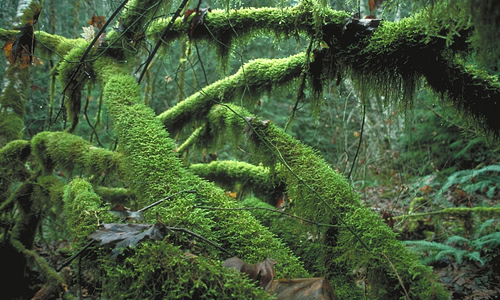Which Strata Of The Rainforest Is Teeming With Animal Life Especially Insects
The rainforests are abode to more than than half the animals in the world. Rainforest animals reside in all four stratas of the wood. 'Strata' ways 'layers'. Scientists carve up rainforests into different strata (or layers) for easy reference.
Each of these layers is a very different environment and supports different life forms.
The stratas differ in many ways, including temperature, the corporeality of sunlight that they receive, the wetness of the surround and the amount and types of life forms living in it.

Rainforest Emergents

Many birds such as colorful Macaws, mammals such as monkeys and insects such as tropical butterflies reside in the tops of the trees that are taller than any other trees in the world. The Emergent layer gets most of the sunlight and can be quite windy sometimes.
Trees, shrubs and plants of every kind struggle to reach the light. Emergent trees are very top heavy and take almost no side branches beneath the canopy.
Rainforest Canopy

The upper parts of the trees house birds, insects, arachnids, reptiles and mammals in its leafy environment. It is referred to as an 'umbrella'. Trees such as the Castor Box be in the Canopy and act as a home for birds, possums and plants. The trees in the Canopy entwine to make a very thick embrace which is generally 60 – 130 feet above the ground.
At the superlative, rainfall is heavy, the winds are strong and humidity is fairly loftier. Many of the trees have their branches intertwined and they are likewise tied together past many kinds of creepers and vines. Lianes are climbing woody plants that are rooted in the ground and use other plants as support so that they can reach the light.
Rainforest Understorey

A nighttime, cool environment that gets little sunlight and therefore has limited plant life. There are ordinarily curt, green, leafy shrubs, generally non-flowering, small trees, ferns and vines. Epiphytes are plants which perch on or attach to other plants. They collect water in a multifariousness of ways from rain and get nutrients from organic matter. Mosses, lichens, orchids, ferns, elkhorns, staghorns and bird nest ferns are Epiphytes that grow in the Understorey. The Understorey is domicile to many insects and birds.
Rainforest Floor

The forest floor is teeming with animal life particularly insects and arachnids, too larger animals such as jaguars, pumas, gorillas, anteaters and big snakes similar the anaconda and the Boa Constrictor. It is as well the most boiling part of the Rainforest. In that location is no grass here. The underlying soil is subconscious past a thin layer of rapidly rotting leaves, twigs and dead flowers.
The work of decomposing this litter layer is carried out by plants like fungi and animals and insects like ants and termites likewise as worms.
People also live on the woods floor.
Rainforests
Tropical rainforests are forests characterized by high rainfall, with definitions setting minimum normal almanac rainfall between 1750 millimetres and 2000 millimetres. In contradiction to popular belief, rainforests are non major consumers of carbon dioxide and like all mature forests are approximately carbon neutral. Contempo evidence suggests that the majority of rainforests are in fact net carbon emitters.
However, rainforests do play a major function in the global carbon bicycle equally stable carbon pools. Clearance of rainforest leads to increased levels of atmospheric carbon dioxide. Rainforests may also play a role in cooling air that passes through them. As such, rainforests are of vital importance within the global climate system.
Because in that location are multiple co-operative levels and microclimates (a local atmospheric zone where the climate differs from the surrounding expanse), in a rainforest, it is a hotspot for biodiversity. Many species of plants and animals still have withal to be discovered. The rainforest as well provides a multitude of resources for local, indigenous people including food and shelter. A number of plants found in the rainforest can also exist used for medicinal purposes.
Rainforest Conservation
By speaking with the local people living in and effectually the rainforest, conservationists can learn information that would allow them to best focus their conservation efforts.
Another fashion conservation has get the most economically beneficial option is through carbon credits (a key component of national and international emissions trading schemes). Under the Kyoto Protocol (an amendment to the international treaty on climate alter), countries must reduce their emissions of Carbon Dioxide past 5% below the 1990 levels before 2012.
Countries can meet their mandatory cuts in emissions by offsetting some of those emissions some other way. Through conservation or reforestation of the rainforest, countries tin can receive carbon credits.
Rainforest Animals
Source: https://animalcorner.org/rainforests/canopy-layers/
Posted by: smoothitery.blogspot.com

0 Response to "Which Strata Of The Rainforest Is Teeming With Animal Life Especially Insects"
Post a Comment